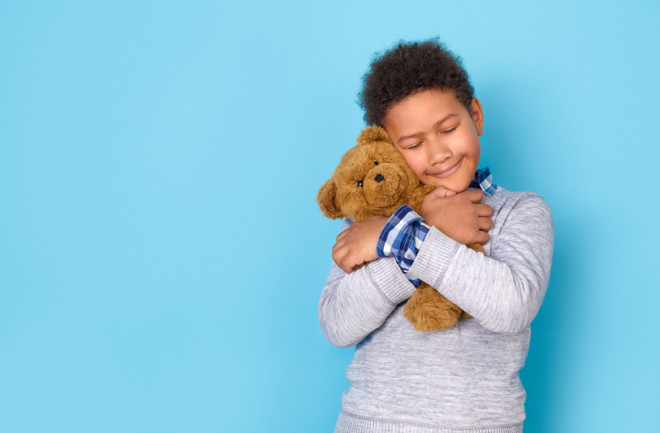In late 2019 and early 2020, bushfires in Australia destroyed the habitat for millions of animals as well as homes for thousands of people. UNICEF estimated that the fires somehow impacted 40 percent of Australian children.
Many children felt traumatized by the fires, and because teddy bears have the power to calm and comfort, UNICEF organized therapy sessions with handmade teddy bears that children could keep and cuddle.
Researchers are learning more about the emotions people attach to teddy bears and then maintain throughout their lives. The science behind teddy bear hugs has the potential to help clinicians treat anxiety, reduce fear and address trauma.
Read More: Should Children Be Screened For Anxiety?
Bearology
Research has found that teddy bear comfort starts early in life. For young children, teddy bears serve as a source of assurance as they transition to being more independent from their parents. Touching teddy bears has also enabled kids who feel excluded to be more prosocial in their interactions with other kids.
Making Life Bearable
Psychologists in the 1950s turned to teddies to see how children used stuffed bears to cope when they felt insecure or scared. In recent years, psychologists have used teddy bears to help traumatized or fearful children respond to upsetting situations.
In one Israeli study, for example, preschool-aged children acted as parents to their teddy bears and admitted them to a teddy bear hospital. The children watched their bears undergo medical testing and receive shots. They later showed less anxiety about hospital settings than a control group. Similarly, children in a German study visited a teddy bear hospital and demonstrated more health knowledge than a control group.
Thus, empirical studies have found that teddy bears are beary good at reducing fear, providing comfort and enhancing knowledge. And a team of French scientists recently learned more about why teddy bears have the power to soothe.
Beary Comforting
In a 2022 study in The Journal of Positive Psychology, French researchers wanted to understand the physical and sensory characteristics that made a teddy bear cuddle worthy.
The team recruited 395 participants in 13 French cities. Sixty percent of the participants were female, and the average age was 18. The median age was 12, and 75 percent of the participants were younger than 27.
The team also recruited eight stuffed bears into their study, including a panda, a baby blue colored bear with long legs, and a fuzzy chocolate brown bear. They referred to these eight stuffed animals as the "standard bears," and they were mailed from one test location to the next.
The participants were invited to bring their own bears, and 48 percent brought their best ones. "Loaner bears" were supplied to the participants who didn't have one or brought a stuffed animal that didn't meet the study's criteria. (Only bears were accepted into the study. Alas, stuffed monsters, pigs or puppies were denied participation.)
Researchers gave participants a list of tasks that required them to spend time with their standard bear. The tasks included answering a questionnaire about their standard bear, taking measurements and photographing it in a makeshift photo studio. Another standard bear, referred to as the "stranger bear," was introduced toward the end of the session.
Participants were asked which bear they would most likely cuddle if they felt sad or scared — their own (or loaner), standard or stranger bear.
Participants overwhelmingly preferred their own bears over the standard and stranger bears. The answers revealed they had strong emotional bonds toward the bear they brought, enabling them to see their bear as a source of comfort.
The study also found that participants rated bigger bears as more comforting. Fur type also mattered; softer bears were perceived as more comforting than bears with coarse fur. The authors concluded that emotional bonds were the strongest factor in whether a bear was perceived as comforting. Other characteristics, such as size and softness, also played a role.
Read More: The Surprising Benefits of Emotional Support Animals
A Century of Cuddles
The history of the teddy bear dates to November 1902, when President Theodore Roosevelt wasn't having much luck on a hunting trip in Mississippi. The other hunters in his group each shot a black bear, but Roosevelt was unsuccessful. Given that he was the POTUS, others in the group wanted to make sure he also bagged a bear.
A few assistants cornered a young bear, tied it to a tree and encouraged the president to take his best shot. Reporters watched as Roosevelt refused to raise his rifle. He argued that shooting an injured and restrained animal wasn't fair.
The story went viral, 1902 style and a political cartoonist mocked the president for being soft. Toy makers responded with plush "Teddy Bears" that was instantly popular. One historian noted how teddy bears came into popularity when Americans feared and hated wild bears.
By the 1930s, teddy bears less resembled the scary wildlife versions and became more baby-like in their features. Teddy bears now have wide foreheads and little mouths and noses. Their faces are typically sewn into smiles, not snarls.

